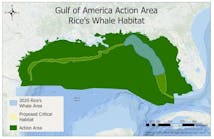EPA, Army Corps of Engineers issue final rule on Clean Water Act jurisdiction
The Biden administration has issued, as promised, a final rule restoring the Obama administration’s working definition of the jurisdiction of the Clean Water Act. The issue complicates life for oil, gas, and pipeline companies trying to determine what permits they need for projects that may disturb isolated lakes, ponds, wetlands, and intermittent streams.
The Environmental Protection Agency (EPA) and the US Army Corps of Engineers jointly released the final rule Dec. 30. It is to take effect 60 days after publication in the Federal Register.
The regulators’ announcement said the rule “returns to a reasonable and familiar framework founded on the pre-2015 definition with updates to reflect existing Supreme Court decisions, the latest science, and the agencies’ technical expertise.”
“The rule’s clear and supportable definition of waters of the United States will allow for more efficient and effective implementation and provide the clarity long desired by farmers, industry, environmental organizations, and other stakeholders,” said Michael Connor, assistant secretary of the Army for civil works.
The fundamental problem has been the lack of a jurisdictional definition in the Clean Water Act, resulting in much litigation over the years and a default reliance on court rulings. Another Supreme Court ruling may be issued this year in the Sackett case, which was argued Oct. 3 (OGJ Online, Oct. 3, 2022).
Tough issues addressed
The EPA and the Corps of Engineers did not shy away from the difficult issues of protection for what the Clean Water Act vaguely calls “navigable waters” and “the waters of the United States” (frequently referred to as WOTUS).
The agencies released a fact sheet saying federal jurisdiction will cover not only interstate waters, their tributaries, and their adjacent wetlands, but all other waters whose use, degradation, or destruction could affect interstate commerce. Those “other waters” include any waters that could be used by interstate travelers for recreational purposes, from which fish or shellfish could be taken and sold in interstate commerce, and which could be used for industrial purposes by industries in interstate commerce.
The other water bodies that could be covered by the rule include “intrastate lakes, rivers, streams (including intermittent streams), mudflats, sandflats, wetlands, sloughs, prairie potholes, wet meadows, playa lakes, or natural ponds.”
“Prairie potholes” are lakes, ponds, and wetlands that dot the region of the Williston basin of North and South Dakota and eastern Montana. In that area, including the Bakken shale, oil production sites and pipelines routinely are developed amid numerous small water bodies unconnected to interstate waters.
The reversion to a pre-2015 definition avoids the problems encountered when the Obama administration in 2015 adopted a more expansive determination of Clean Water Act jurisdiction that was repealed by a Trump administration rule in 2019.
The Trump administration completed its own final rule in January 2020 that narrowed the jurisdiction of the Clean Water Act, a step welcomed by spokesmen for the oil and gas industry as a clarification and a reduction in regulatory burdens (OGJ Online, Jan. 24, 2020). That definition was tied up in courts, which means the agencies have been operating under the pre-2015 definition to the present.
Lack of clarity
Despite the Biden administration’s hope for “a clarity long desired” by industry, farmers, and others, litigation has been a constant for the Clean Water Act—before and after 2015. The Supreme Court’s SWANCC decision in 2001 and its Rapanos decision in 2006 became landmarks for restraining the reach of the federal regulators.
The Rapanos decision gave the Corps of Engineers a setback but failed to resolve the underlying legal issue because the justices were splintered in the case, issuing five opinions. After that ruling, EPA and the Corps chose to adopt a “significant nexus” test, which was one justice’s idea that the agencies should assess the significance of a connection to jurisdictional waters.
The Rapanos decision may be overhauled by the Supreme Court in the pending Sackett case. Environmentalists fear the court will decide a continuous surface water connection is needed for jurisdictional waters, an approach that would leave isolated water bodies and wetlands out of the federal picture. That approach was adopted by the Trump administration with applause from the oil and gas industry.

